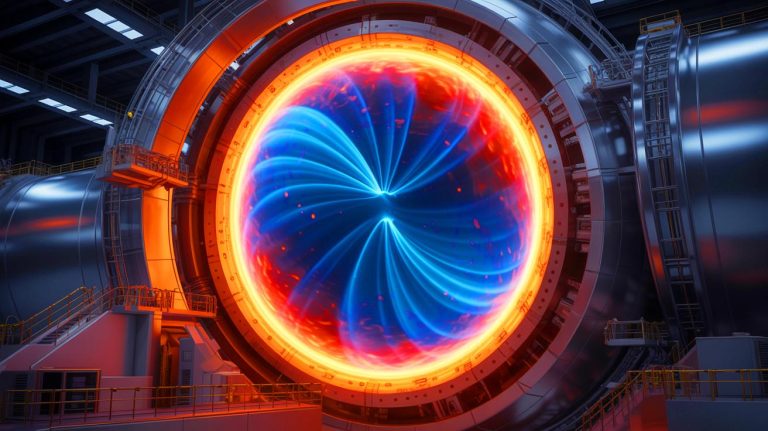| IN A NUTSHELL |
|
In a groundbreaking development in the world of nuclear fusion, scientists at the Wendelstein 7-X (W7-X) facility have achieved a historic milestone. For the first time, high-energy helium-3 ions have been generated using ion cyclotron resonance heating. This achievement marks a significant step forward in fusion research, potentially paving the way for future fusion power plants. The implications of this discovery extend beyond terrestrial energy solutions, offering insights into cosmic phenomena and the inner workings of our sun.
The Significance of Ion Cyclotron Resonance Heating
The W7-X facility, known as the world’s largest stellarator, has made a remarkable breakthrough with the generation of helium-3 ions. This was accomplished using a sophisticated technique called ion cyclotron resonance heating (ICRH). This method is akin to pushing a child on a swing; each push must be in resonance with the swing’s natural frequency to be effective. By utilizing powerful high-frequency waves, scientists were able to accelerate helium-3 ions to high energies.
ICRH plays a crucial role in sustaining the super-hot conditions necessary for ongoing fusion reactions. This process involves feeding electromagnetic waves into a plasma containing hydrogen and helium-4, and tuning them to the specific frequency at which helium-3 ions naturally orbit the magnetic field lines. This technique allows the particles to efficiently absorb energy, sustaining the extreme temperatures required for continuous fusion reactions.
Simulating Conditions with Helium-3 Ions
Given the experimental nature of W7-X and its scaled-down design compared to a full-fledged fusion power plant, scientists simulate the conditions needed for fusion using lighter, lower-energy particles like helium-3 ions. These ions are accelerated to a suitable energy level through ICRH, simulating the behavior of high-energy alpha particles in a full-scale reactor.
The successful generation of high-energy helium-3 ions in a stellarator is a world first in fusion research. This experiment not only demonstrates the potential of stellarators for future energy solutions but also offers a unique platform for understanding fundamental plasma physics. The collaboration under the Trilateral Euregio Cluster (TEC) has been instrumental in developing and operating this ICRH system, showcasing the strength of international scientific partnerships.
From Nuclear Fusion to Unveiling the Universe’s Mysteries
The implications of this innovation extend far beyond Earthly energy production. Researchers have discovered that the resonant processes driving helium-3 particles in W7-X might explain some of the sun’s enigmatic behaviors. Specifically, these processes could account for the occasional formation of helium-3-rich clouds in the solar atmosphere, which contain up to 10,000 times more helium-3 than usual.
This research not only contributes to the development of a sustainable energy source but also provides unexpected insights into the cosmos. Understanding these resonance processes helps scientists unlock the mysteries of the sun and other celestial bodies, highlighting how fusion science is shaping our understanding of the universe.
The Future of Fusion Research and Energy Solutions
The accomplishments at W7-X represent a significant step toward realizing the dream of sustainable fusion energy. By overcoming the challenges of containing super-hot plasma and maintaining high-energy conditions, scientists are closer than ever to developing practical fusion reactors. These reactors could potentially provide a clean, unlimited energy source, significantly reducing reliance on fossil fuels.
As researchers continue to refine these technologies, the potential for fusion energy becomes increasingly tangible. The ongoing collaboration between international scientific communities underscores the importance of shared knowledge and resources in advancing this field. The breakthroughs achieved at W7-X serve as a testament to what can be accomplished through dedicated research and innovation.
As we stand on the cusp of a new era in energy production, the question remains: How soon will these advancements in fusion technology translate into real-world energy solutions, and what impact will they have on our global energy landscape?
Did you like it? 4.4/5 (25)






Wow, this is like something out of a sci-fi movie! Helium-3 in fusion? 🚀
Is anyone else worried about the costs of developing these technologies? 💸
Bravo to the scientists who made this happen! Truly groundbreaking! 🎉
How does this affect our understanding of the sun and its behavior?
Why is helium-3 so important, and why haven’t we used it before?
Fusion energy has been “around the corner” for decades. What’s different now?
This is just the beginning! Can’t wait to see what comes next. 🚀
Finally, some good news in science! Thank you, W7-X, for leading the way!
Can someone explain how ion cyclotron resonance heating actually works? 🤔
Could this advancement impact other areas of technology or science?
I’m curious, how does this discovery affect our current energy policies?
As exciting as this is, feels like we’re still far from practical applications. 😕
Any idea if this will lead to new job opportunities in the energy sector?
Should we be worried about any risks associated with helium-3 fusion?
Is helium-3 abundant enough on Earth to support this kind of energy production?
When can we expect the first commercial fusion reactor using this technology?
Helium-3-rich clouds in the sun’s atmosphere? That’s mind-blowing! ☀️
I hope this leads to cleaner energy solutions and helps combat climate change. 🌱
Does this mean we’ll soon have spaceships powered by helium-3 fusion? Cool! 🚀
Is this a global effort or primarily led by a specific country or organization?
This is amazing! Finally, some real progress in fusion energy! Thank you to all involved! 🌟
How does this discovery overlap with other alternative energy sources?
With all the advancements, why is fusion energy still not commercially available?
What are the next steps in research after this significant achievement?
I’m no scientist, but this sounds like a big deal. Keep up the great work! 👏
Wait, does this mean we can soon have fusion power plants? How long will it take?
As exciting as this sounds, is it really feasible to use helium-3 on a large scale?
I’m skeptical. We’ve been hearing about fusion breakthroughs for years but still no power plants.
Great achievement! But how does this compare to tokamak technology?
So, when will we see lower electricity bills thanks to fusion energy? 😅
Incredible work by the W7-X team! This could revolutionize energy as we know it. 🌍
Are there any potential environmental impacts of using helium-3 in fusion?
ICRH sounds pretty cool, like charging particles with a cosmic battery! ⚡